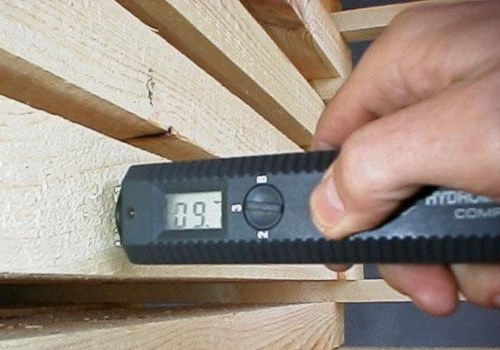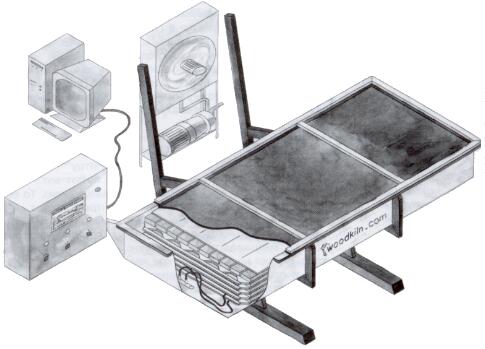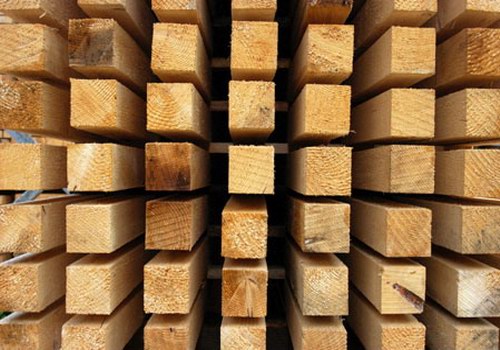For construction and finishing works, dry raw materials are needed for the manufacture of furniture and other works with wood. Fresed wood contains a significant amount of moisture and therefore unsuitable for use. Over time, it may be swore, cracking, its surface is susceptible to the fungi and insect pests. Paint and varnish protective equipment in this case will not help: drying sawn timber before using them.
Content
The essence of the drying process
The main task of the wood drying is the evaporation of moisture from its array. The process occurs gradually: first dries the surface of the sawn timber, and from the middle layers moisture is shifted, after which everything is repeated. As a result, the moisture content of wood and the surrounding air is compared. Humidity is expressed as a percentage, and it denotes the share of water contained in the wood in relation to the mass of absolutely dry material. In order for it to be used, the humidity parameter should be reduced from 60-90% (fresh wood) to 15% (for construction) or up to 8-10% (for furniture production).

Drying speed depends on the initial humidity, air temperature, air traffic intensity, wood breed and other factors. The technology of drying sawn timber playing an important role.
Wood drying methods
Wood dry after sawing roundabouts on the boards: so more convenient and more efficient. There are two ways of drying:
- natural: it can be carried out in domestic conditions, while special equipment does not apply;
- artificial: To implement the process, drying installations are needed, capable of maintaining the required mode (ventilation, temperature).
Artificial drying is produced at woodworking enterprises, while the process rate of the process is selected depending on the wood breed.
Wood preparation for drying
- Wood cleaned from the bark using a special tool. It is necessary to get rid of the habitat of microorganisms and insects.
- Cutting is performed on the bars or boards in size of the drying chamber.
- The material into the chamber is laid with a breaking in width so that its deformation in the drying process has not created interference. The change in the form is due to a decrease in volume.
Natural drying of lumber
A small amount of boards or bars can be dried in an urban apartment or a private house. The benefits of this is obvious: it is not necessary to pay for the services of the sawn timber to the woodworking company, does not require special equipment and do not have to pay large electricity bills.
During the drying, it is impossible to use heating devices: this will lead to the warming and appearance of cracks. It is recommended to place wood higher, for example - on the closet. After three weeks, the sawn timber will be ready for use.
On the foundation of the private house, the conditions are more suitable. Atmospheric drying of lumber (so called this method) in this case is organized and controlled as follows:
- The boards are laid by the stack on the supports, the same in height. The base should be smooth and horizontal. The height of the support is about half a meter.
- Between the rows there must be gaskets from dry material: it contributes to ventilation. The gaskets are laid out at a distance of 1.5 - 2 m from each other. They should be located exactly above the pile supports, the thickness of the gaskets should be the same.
- So that the wood is not swamped as a result of the effects of sun rays, over the stack build a light roof from the rubberoid or slate. She will protect and from rain.
- You can use a valve attic to natural drying. At the same time, the drying of lumber is periodically controlled: the issue price is the absence of mold and in the end - high-quality raw materials.
- The drying time of sawn timber in the summer is 30 days (for boards with a thickness of 50 mm). If necessary, dry the logs, you will have to wait for about three months.
- In the case of the use of wood for the manufacture of furniture, an additional drying is needed in the house, it will remove the internal stresses.
- A sign of dryness of the material may be chip fragility: the land of the wood, the easier it will be to break the fresh chips.
In addition to "pluses", such a method of drying has disadvantages:
- the process takes a lot of time;
- there is a dependence on the weather: winter drying is almost impossible;
- it is impossible to achieve a low material moisture value: the limit is determined by the ambient air;
- there is a risk of wood humidity set when changing external conditions (during rain or fog).
Artificial drying of wood
Such technology is available for forest processing enterprises. Drying is carried out in special premises, in conditions of artificially created microclimate, changes in which are monitored by a special program.
The advantages of this method are as follows:
- lumber dries several times faster than when drying at home;
- there is no dependence on weather conditions;
- wood can be dried to low humidity values, due to the possibility of accurate process adjustment;
- it takes less space for the organization of the process, thanks to the compactness of the equipment.
The costs of the need to use special equipment and high electricity costs pay off in a short time.
For artificial drying, several ways have been developed:
- chamber drying of sawn timber;
- contact drying;
- vacuum drying of sawn timber;
- drying in the electric TSF (high frequency currents);
- drying with hydrophobic liquids.
We will tell you more about each way.
Cameras for drying lumber: Download rules

When operating a drying chamber, you must perform the following rules.
- Lumber packages must be prepared in advance and are folded close to the camera. So you can speed up the download.
- Packets of lumber must be smoothly folded and transported. This will avoid damage to the walls of the chamber, ceiling and heating radiators.
- After unloading sawn timber after drying, it is necessary to carefully clean the camera from sawdust, chips and bark to avoid clogging radiators. Otherwise, air convection will be limited, which will lead to a deterioration in the quality of the wood of the next party, the appearance of "sinushesity" and an increase in drying time.
- To reduce the amount of garbage in the chamber, the packages before downloading is recommended to clean from the lunned bark.
- Drying packages should be equipped with needle sensors fixed at a certain distance. This is necessary to control the drying process. The depth of the needle should spread to the entire thickness of the sawn timber, otherwise the control will be limited to the surface layer. This will further reduce the volume of sawn waste during their processing.
- Install the sensors in those places of the package where the drying will occur slower. Lower packages dry longer.
- Nozzles should be controlled: the water leakage is easy to notice on the puddles in the chambers, after their idle for several hours. Heat mains going to the drying chamber must be isolated with low thermal conductivity materials. The service personnel must periodically check the condition of the camera.

The video about how the chamber drying process occurs.
Contact drying
The process is based on the transfer of heat to wood from the heated surfaces of the plates. This method is suitable for drying plywood veneer, curved furniture and sawdust parts. The advantage of this method in the high intensity of heat transmission drying materials due to the large area of \u200b\u200bcontact. In essence, there is a evaporation of moisture with heated surfaces and therefore the method is fire hazard.
Podium drying (using combustion products) may be accompanied by sprinkling, because this type of contact drying is rarely used. More popular wood heating steam (drying hydropress, respiratory press): This method is used for drying plywood and veneer.
Vacuum drying

The dryer, working on this technology, is a hermetic chamber of stainless steel. From above - rubber coating fixed in a metal frame. The chambers in the chamber are located layers, between which the heating plates are stacked from aluminum. Inside the plates circulate hot water supplied to the pump from an external boiler. Vacuum in the chamber is created by a liquid vacuum pump.
After loading wood on the control panel, the pressure level (vacuum) and the heating temperature are set.
The whole drying process by a vacuum method consists of stages:
- heating without inclusion of vacuum pump (at atmospheric pressure);
- drying under vacuum conditions;
- air conditioning and cooling (wood cools under vacuum conditions, which avoids its deformation).
Drying in the electric field
The use of direct heating using electricity accelerates the drying process. The heat transfer occurs evenly and therefore the quality of the wood rises. At the same time, the method is used to heat the dielectric in the electrical field of the condenser. Thermal energy is transmitted to wood and moisture contained in it, evaporates when the temperature is reached above 100 ° C. Drying speed by such a method of tens times large than under a convective process. The disadvantage is in large electricity spending.
Drying with hydrophobic liquids
It is used to further protect the wood before processing it with oil antiseptics. Melted metals, sulfur, paraffin, solutions of mineral salts and other hydrophobic substances are used for this process.
Wood is lowered into the liquid that is brought to a boil. A constant temperature is maintained until the gas bubbles are released, which will indicate the full removal of moisture. The duration of such a drying is up to 20 hours.
There are other wood drying methods: induction, radiation, infrared. Your attention video demonstrating the process of infrared wood drying.






















I would add to high-quality drying - Press Vacuum Drying Cameras PVS, which for 18-20 hours allow you to dry the sawn timber with very high quality. Wood after the press of vacuum drying is more dense, preserved decay products, it absorbs moisture in the process of manufacturing the product and grips well. 1 PVS-6T Camera per month allows you to dry 60 cubes, with lowest energy consumption - 120 kW per cubic meter. In the same chamber also produced thermomets.